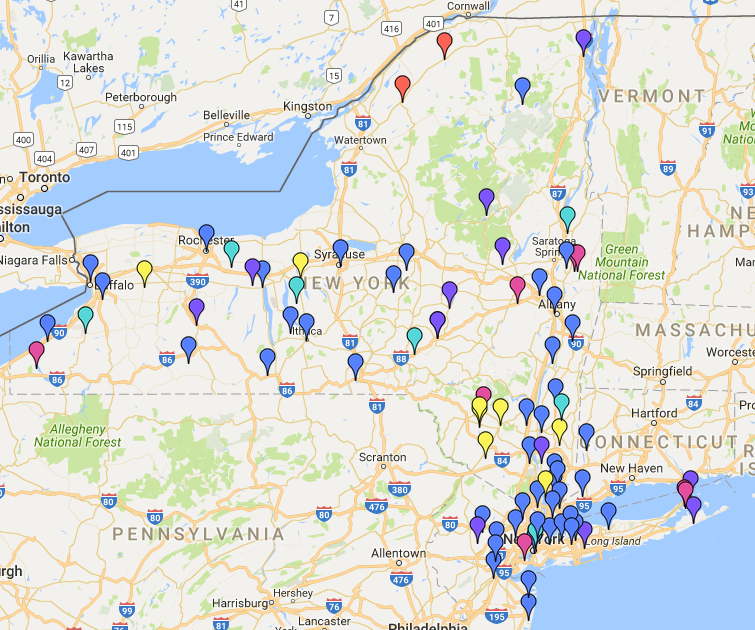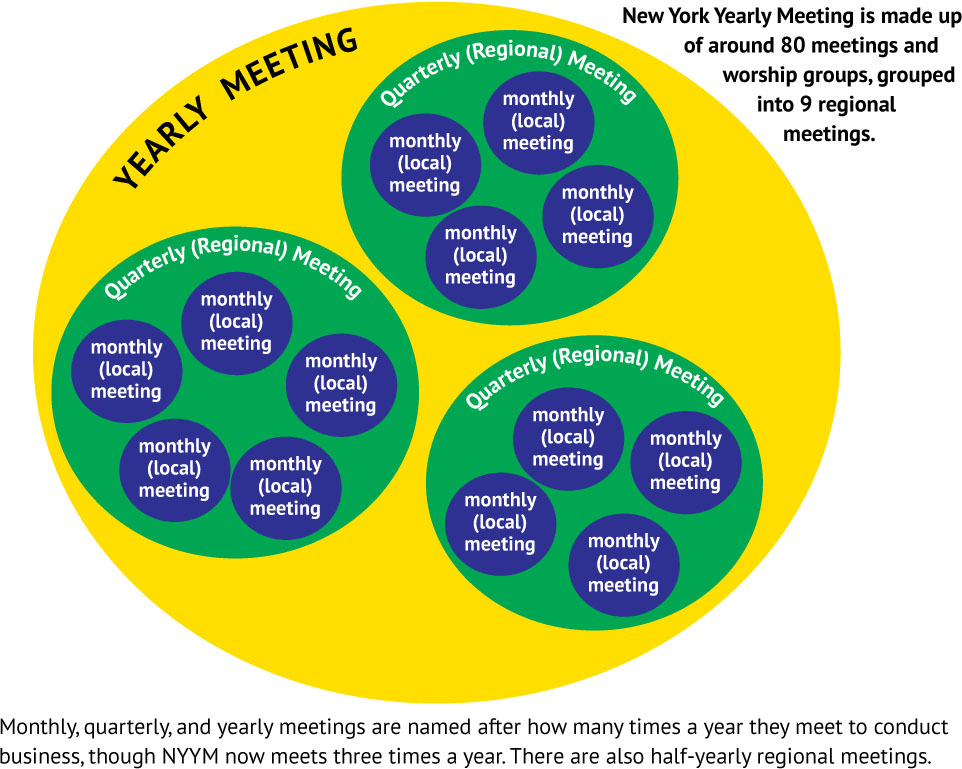PART 1, ORGANIZATION
STRUCTURE OF NEW YORK YEARLY MEETING
1. Organization
The legal aspects of the New York Yearly Meeting are described in the section on “Corporation and Trustees” General Services section.
The Yearly Meeting is organized and conducts its business affairs under the guidance of the book of Faith and Practice of New York Yearly Meeting. Its essential organization is suggested in Section B of Faith and Practice but not spelled out in great detail.
The following officers are appointed annually for one-year terms:
Clerks—A presiding clerk and an assistant clerk
Two or three recording clerks
Two or three reading clerks
Treasurer and assistant treasurers
Some committees are specifically established in Faith and Practice (“Practice and Procedure” section), and other committees may be appointed and laid down as circumstances warrant. It is largely through committees that the Yearly Meeting meets its responsibilities.
2. Terms of Service
All appointments to Yearly Meeting committees or other bodies are made for a specific term as indicated in each committee or group’s description in the Handbook (three years in most cases). Service for the term specified by the Nominating Committee commences at the close of the business session in which the appointment is approved, unless otherwise noted or directed by the Yearly Meeting. A record of all committees and their membership is published annually in the Yearbook, along with the minutes and proceedings of Yearly Meeting sessions.
Committee members who have served six consecutive years or two consecutive terms, whichever is longer, ordinarily are not renamed without an intervening period of one year. Friends who wish to request release from service or who need to resign are asked to submit their request in writing either electronically or by postal mail to the New York Yearly Meeting clerk, with copies to the committee clerk, the appropriate coordinating committee clerk, the Nominating Committee clerk, and the New York Yearly Meeting office. Friends should request release when they find they cannot participate in the work of the committee, permitting the Yearly Meeting Nominating Committee to find Friends to fill vacancies in a timely manner.
3. Appointment & Duties of Yearly Meeting Officers
a. Yearly Meeting Clerks—The clerks are appointed for one-year terms by the Yearly Meeting at its summer business sessions upon the recommendation of the Nominating Committee. Their terms of office begin at the close of the Yearly Meeting sessions at which they are appointed, except that a retiring clerk is responsible for the proper recording of the minutes of the Yearly Meeting just concluded and attesting to their accuracy if needed, and may be called upon to sign documents approved for sending by the Yearly Meeting.
The presiding clerk presides over the business sessions of the Yearly Meeting, presents the various items of business or introduces those who will present them, and gathers the sense of the meeting with respect to the business presented. The clerk is responsible for signing (physically or electronically) the completed minutes and sending them to the Yearly Meeting office for publication and distribution by the staff. The clerk may be called upon in various ways to represent the Yearly Meeting between sessions and is authorized to speak on behalf of the Yearly Meeting (see Minute 200?-xx-xx) but has no power to act in the name of the Yearly Meeting except as specifically authorized by minute.
The clerk is a member ex officio of the General Services Coordinating Committee, the Liaison Committee, the Sessions Committee, the Central Committee of Friends General Conference, and New York State Council of Churches. The Yearly Meeting may also ask the clerk to serve ex officio on various ad hoc and working groups that arise.
The assistant clerk may conduct business sessions at Yearly Meeting and performs such other duties as the clerk may assign. The assistant clerk is a member ex officio of the Sessions Committee and the General Services Coordinating Committee.
If an assistant clerk is unavailable during business sessions, the clerk of the day (whether presiding or assistant) may name an acting assistant clerk for the session.
The recording clerks record the actions of the Yearly Meeting as determined by the clerk and approved by the body. They share this responsibility in such a way as to be mutually acceptable to them and to the clerk. The reading clerks read letters and other communications written to the Yearly Meeting. They share this responsibility in such a way as to be mutually acceptable to them and to the clerk. The reading clerks should have good speaking voices and be familiar with Friends’ vocabulary and the pronunciation of individual Friends’ names.
b. Treasurers—The treasurer is appointed to a one-year term by the Yearly Meeting upon the recommendation of the Nominating Committee, but the term of office begins at the first of the calendar year next succeeding the appointment, thus corresponding with the fiscal year of the Yearly Meeting. The treasurer receives and disburses funds of the Yearly Meeting, has responsibility for the bank accounts in the name of the Yearly Meeting, and may make deposits and sign checks with- out counter signature. The treasurer is a member ex officio of the General Services Coordinating Committee and the Financial Services Committee.
The assistant treasurer is appointed for a one-year term by the Yearly Meeting upon the recommendation of the Nominating Committee, but the term of office begins at the first of the calendar year next succeeding the appointment, thus corresponding with the fiscal year of the Yearly Meeting. The assistant treasurer has authority to assume the duties of the treasurer, should that become necessary. The assistant treasurer is a member ex officio of the Financial Services Committee. The Yearly Meeting may appoint a second assistant treasurer at its discretion.
4. Yearly Meeting Staff
Responsibility for the Yearly Meeting’s life and activities is carried out by its members; however, it has been desirable to employ salaried staff to carry out some functions. The staff supplies specific skills and a consistent level of attention to routine as well as continuity, experience, and breadth of view.
In fostering the spiritual life of the Yearly Meeting, staff members may visit meetings and develop and share understanding of common problems within the Yearly Meeting. Frequently the staff can suggest approaches to challenges by sharing personal experience and the experience of other monthly meetings. This sharing between meetings and the ongoing attention of staff members supplement the work of the Yearly Meeting and nurture the life and health of the Yearly Meeting.
In addition, the staff supports volunteers in organizing and conducting its sessions. Staff maintains Yearly Meeting records (Sharing Fund, address lists, and the like). It also carries out specialized work (preparing Spark, the Yearbook, and other publications). The staff provides clerical work in support of the Yearly Meeting Clerk.
The Personnel Committee develops job descriptions, which are available in the Yearly Meeting office. The Yearly Meeting upon recommendation of the Personnel Committee appoints the staff for terms of service specified in the minute of appointment. Staff persons are employees of the Yearly Meeting and are paid by the Yearly Meeting treasurer.
The present job titles are available from the Personnel Committee.
5. Yearly Meeting Sessions
The Yearly Meeting meets three times a year to consider its business. In addition to the business sessions and meetings for worship, it has been our custom during the six-day residential Summer Sessions for Friends to meet in worship-sharing groups, committee meetings, interest groups, and Bible-study groups, and to hear invited speakers. During summer sessions, Junior Yearly Meeting provides a program for young people pre-kindergarten through high school age.
Spring Sessions are held during a weekend in April, and Fall Sessions on a November weekend. At Fall Sessions the Financial Services Committee typically proposes the Yearly Meeting’s annual operating budget for the following fiscal year, starting on January 1st.
The nine regional meetings rotate hosting opportunities for Spring and Fall sessions, supported by the Sessions Committee. The Youth Committee works with the host committee to coordinate a program for young people aged 6–17.
6. Participation in Yearly Meeting Sessions
All members of monthly meetings are members of the Yearly Meeting, and are asked to participate as fully as they are led and able in the work of this wider body of Friends, just as in their home meeting. In order to encourage participation that reflects the body of the Yearly Meeting as a whole, monthly meetings are asked to name representatives to the Yearly Meeting sessions. During the spring quarter, each monthly and executive meeting shall appoint at least one representative for a term of three years. Additional appointments are made in proportion of one representative for each seventy-five members of the monthly meeting.
An information sheet entitled “On Serving As a Named Representative" is in section 2 p??. If a named representative is unable to represent the appointing meeting, that meeting should name a replacement as soon as possible. Meetings are also asked to name alternates if named represent- tives are unable to attend a particular session of Representative Meeting. Names of the alternates should be sent to the presiding clerk in advance of the sessions.
A tabulation of the numbers of named representatives for each monthly meeting is printed in the Yearbook and is updated each year.
Special meetings may be held upon the call of any five named representatives upon ten days’ notice by mail, telephone, or telegram to all named representatives. (Faith and Practice, page 109, 2001 edition.)
7. The Sections
The activities of the Yearly Meeting are carried out by four specialized sections:
The Ministry Section exercises general care of the ministry and spiritual life of the Yearly Meeting; it assists in pastoral care; it organizes conferences of Friends for sharing its concerns; and it conducts other activities to foster spiritual growth.
The General Services Section provides the main administrative, financial, and reporting services of the Yearly Meeting, including the operation of the Yearly Meeting office.
The Nurture Section provides for the advancement of the principles of Friends, for educational and nurturing services of the Yearly Meeting, and for relationships with a number of the wider bodies of the Religious Society of Friends.
The Witness Section makes visible both the traditional testimonies and newer concerns of Friends in ways that extend beyond the Society of Friends. Its work attempts to express beliefs in action.
Each section includes all those named to its constituent committees and its coordinating committee.
Functions of Each Section
- To develop and coordinate services and programs and to implement them directly or through committees, task groups, staff, or volunteers. To adapt services and programs to changing needs and interests of Friends and to resources available; this may involve establishment, consolidation, and laying down of committees.
- To explore new ways of service and to respond to concerns of individual Friends, monthly and regional meetings, and the Yearly Meeting, including:
- Communicating effectively with constituent meetings and individual Friends by written publication, visitation, or other methods.
- Working toward decentralization of services and programs and full participation of monthly and regional meetings.
- To recommend for Yearly Meeting action any major change of activity within its general area of responsibility.
- To work with the Sessions Committee in development of programs for Yearly Meeting sessions.
Each section has a coordinating committee, composed of representatives chosen by its constituent committees and groups plus members at large appointed by the Yearly Meeting. In addition, the Ministry Coordinating Committee has representatives named by the regional meetings.
The coordinating committees are enabling bodies. They consider the activities within the sections in relationship to each other, assist in their coordination, and help allocate the resources of people, time, and money. They coordinate the preparation of the section budgets, are responsible for their overall administration, and participate in preparation of the Yearly Meeting operating budget. They assist constituent committees and others to prepare business coming before Yearly Meeting sessions, and with presentation of business for the consideration of Friends.
The coordinating committees meet from time to time throughout the year to receive reports, suggest courses of action, and advise or act on concerns that come from meetings and individual Friends as well as from groups within their own sections.
Liaison Committee
The Liaison Committee provides for communication among the Yearly Meeting on Ministry and Counsel and the other three sections. It identifies and assigns to a particular section or commit- tee inquiries and concerns coming to the Yearly Meeting. It serves in an advisory capacity to the Yearly Meeting and the Yearly Meeting clerk as needed. It meets daily during Summer Sessions, and at other times as needed.
The committee is composed of the Yearly Meeting clerk, assistant clerk, and the clerks of the four coordinating committees. The past clerk of the Yearly Meeting may be asked to serve.
8. Committees and Task Groups
The four sections carry out their activities using committees, Yearly Meeting appointees to Friends bodies, ad hoc committees, task groups, and individual Friends.
Yearly Meeting Committees
The Yearly Meeting may establish or discontinue committees according to need. In general, New York Yearly Meeting committees are suggested by a coordinating committee after the need has been determined. This Handbook is printed to describe the functions of the Yearly Meeting committees and Yearly Meeting appointees to Friends’ bodies. When a committee is established, it is the duty of the Yearly Meeting to approve a statement of its purpose and functions. All appointments are to be made for a specified time. This statement becomes the committee’s Handbook page.
A record of all committees and their membership is published annually in the Yearbook. Terms of service are discussed in Item 2, page 3, of this part of the Handbook.
Each committee and appointee is responsible through its section to meet its purposes, objectives, functions, and activities. Each is expected to conduct an annual self-review using the Accountability Queries listed below, and to relate its activities to the expectations of the Yearly Meeting for the specialized group of which it is a part. (See “Committee Members” Part 2, beginning on page 80.)
Guidelines for committee and section clerks are to be found in Part 2, pages 82–83 and 87–88.





